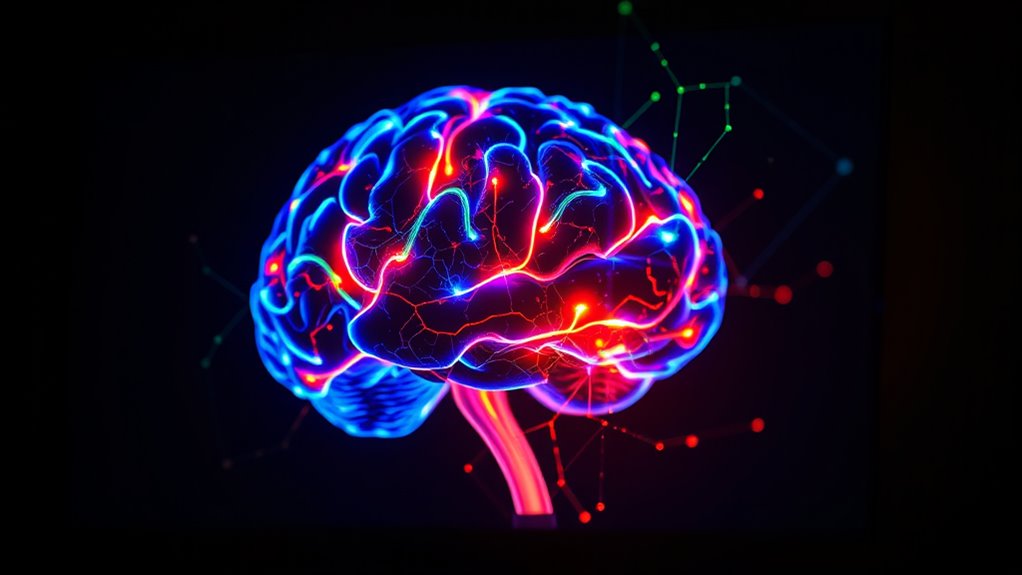Brain imaging shows that compulsive behaviors involve overactivity in regions like the orbitofrontal cortex, anterior cingulate, and basal ganglia, which influence reward, error detection, and habits. However, it doesn’t explain why some people develop these urges or how external factors like stress or trauma play a role. While imaging offers insight into the brain’s involvement, understanding the full picture requires exploring other influences, which you’ll discover as you explore further.
Key Takeaways
- Brain imaging shows hyperactivity in orbitofrontal cortex, anterior cingulate, and basal ganglia during compulsive behaviors.
- Imaging cannot determine whether neural hyperactivity causes or results from compulsions.
- Results vary among individuals, and imaging provides only snapshots, limiting understanding of dynamic processes.
- External factors like stress and trauma influence brain activity but are not visible in scans.
- Combining imaging with behavioral, genetic, and psychological research offers a more comprehensive understanding of compulsions.

Compulsions are repetitive behaviors driven by underlying neural mechanisms that often overpower conscious control. When you find yourself unable to resist certain urges, it’s because your brain’s wiring has shifted in ways that reinforce these habits. Brain imaging studies, especially functional MRI scans, help scientists visualize which areas of the brain light up during compulsive behaviors. These images reveal that regions like the orbitofrontal cortex, anterior cingulate cortex, and basal ganglia are heavily involved. The orbitofrontal cortex processes reward and decision-making, while the basal ganglia play a vital role in habit formation. When these areas become hyperactive or dysregulated, they push you toward compulsive actions, even when you consciously want to stop.
However, brain imaging doesn’t tell the entire story. While it can pinpoint regions associated with compulsive behaviors, it doesn’t fully explain why these regions become so active in the first place. For example, some studies show increased activity in these areas in people with obsessive-compulsive disorder (OCD), but we still don’t know if this hyperactivity is a cause or a consequence of compulsions. Furthermore, imaging results can vary widely among individuals, making it hard to draw definitive conclusions. The complexity of the brain’s network means that multiple regions interact in unpredictable ways, and imaging snapshots can miss these dynamic processes. Additionally, advances in brain imaging technology are continually improving our understanding, but limitations remain in capturing the full scope of neural activity.
You should also understand that brain scans have limitations in capturing the subjective experience of compulsions. While they show which parts of your brain are involved, they don’t reveal how you experience these urges internally. This disconnect means that imaging alone can’t explain why some people develop compulsions while others don’t, or why specific triggers set off these behaviors. It also doesn’t account for the influence of external factors like stress, trauma, or environmental cues, all of which can modulate brain activity and reinforce compulsive tendencies.
In essence, brain imaging provides valuable but incomplete insights into the neuroscience of compulsions. It highlights the neural circuits that are active during these behaviors, but it can’t fully explain the why and how behind their persistence. To truly understand and treat compulsions, researchers need to combine imaging data with behavioral studies, genetics, and psychological assessments. Only then can we start to piece together the full picture of what drives these persistent, often debilitating behaviors.
Frequently Asked Questions
Can Brain Imaging Predict Future Compulsive Behaviors?
Brain imaging can’t predict future compulsive behaviors with certainty. While it reveals which brain areas are active during compulsive acts, it doesn’t provide a definitive forecast of future actions. You might see patterns linked to compulsive tendencies, but many factors influence behavior—emotions, environment, genetics. So, while imaging offers insights, it falls short of reliably predicting what you’ll do next, emphasizing the complexity of human behavior.
How Do Genetics Influence Neural Circuits Involved in Compulsion?
Genetics shape the neural circuits involved in compulsion by influencing how your brain develops and functions. You inherit genes that affect neurotransmitter systems, such as dopamine and serotonin, which regulate reward and impulse control. These genetic factors can make certain neural pathways more sensitive or prone to overactivity, increasing your risk of compulsive behaviors. Understanding this helps you see how your biology interacts with environmental factors in shaping compulsive tendencies.
Are There Differences in Brain Activity Between Different Types of Compulsions?
Yes, different compulsions activate distinct brain regions. For example, obsessive thoughts often involve increased activity in the orbitofrontal cortex, while compulsive behaviors may engage the striatum more intensely. You might notice that compulsions related to checking or cleaning activate specific neural pathways tied to habit formation. These variations help explain why different compulsions respond differently to treatments and why brain imaging can reveal unique activity patterns for each type.
What Role Does Neuroplasticity Play in Treating Compulsive Disorders?
Neuroplasticity plays a vital role in treating compulsive disorders by allowing your brain to rewire itself. When you engage in therapy or medication, you’re helping your brain form new pathways, weakening the old, compulsive ones. This adaptability means you can learn healthier habits and reduce compulsive behaviors over time. By actively participating in treatment, you’re harnessing neuroplasticity to reshape your brain and improve your mental health.
Can Brain Imaging Differentiate Between Obsessive and Compulsive Symptoms?
Brain imaging can’t definitively differentiate between obsessive and compulsive symptoms on its own. You might see overlapping activity patterns in regions like the orbitofrontal cortex and basal ganglia, but these are not specific enough for clear distinctions. Instead, you should combine imaging results with clinical assessments to better understand the nuances of each. Imaging provides valuable insights, but it doesn’t serve as a standalone diagnostic tool for these symptoms.
Conclusion
As you explore the neuroscience of compulsion, remember that brain imaging offers glimpses, but not the full story. What mysteries still lie hidden beneath these scans? Could understanding these unseen forces lead to breakthroughs—or reveal new questions? Keep questioning, because in this complex dance of neurons, every discovery might just unseal the next enigma. The brain’s secrets are tantalizingly close, yet forever just out of reach. Will you uncover what’s truly beneath the surface?









